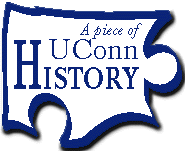
| ||
50 Years Ago ... 1949 As the academic year of 1948-49 drew to a close, many students were shocked to find that they were levied a charge for every staple, thumbtack, and nail hole in their dorm room walls. About 800 students, who received these bills for "excess of normal wear and tear" in the new dormitories, built a bonfire and then marched to President Albert Jorgensen's residence. Jorgensen is reported to have stood on a vehicle (one source says he climbed a nearby utility pole - they used to have footholds for repairmen) and with a bullhorn in hand, calmed the crowd. He promised that the charges - at least for that semester - would be cancelled, and they were. More serious issues were rising in 1949 on campuses throughout the United States, as the civil rights movement began its momentum. That year, trustees enacted a policy prohibiting organizations that discriminate against or exclude persons on the basis of race, religion or national origin. A student referendum endorsed an end to discrimination in fraternities and sororities, but the push and pull of society was coming into play. Some local fraternities were notified that their charters would be suspended by their national organization if they pledged black students. As a result, four UConn fraternities dropped their national status. In 1950, the University stopped furnishing to prospective employers information about the race, color or creed of students; and in 1952 all registration materials were revised to eliminate any reference to race, color or creed. Also in 1949, the University awarded its first Ph.D.s, to Tso-Kan Chang in genetics and Rowland H. Mayor and Samuel Steingiser, both in chemistry.
35 Years Ago ... 1964 And as early as 1947, the University's trustees planned a medical school. No action was taken, however, "for fear that the university's 10-year expansion program might be handicapped" if funds were needed for building a medical school. In 1964, with a 40 percent increase in its enrollment, the School of Law moved into its location at the Hartford Campus. The law school moved to its present location on Elizabeth Street, formerly the Hartford Seminary, in the mid-1980s. Also in 1964, nearly 17 years after their first plan for a medical school surfaced, trustees approved plans for a seven-building Health Center, with schools of medicine and dental medicine and a hospital, for a 106-acre site in Farmington.
15 Years Ago ... 1984 On May 18, the University's main library was named in memory of Homer D. Babbidge Jr., who had served as UConn's president from 1962 to 1972. Babbidge had died nearly two months earlier. Gov. William O'Neill and former Gov. John Dempsey attended the ceremony. Also in 1984, Nathan L. Whetten, first dean of the Graduate School, died on June 25 at the age of 83. An internationally respected scholar, Whetten joined the UConn faculty in 1932 and retired in 1971. The Whetten Graduate Center was named in his honor.
10 Years Ago ... 1989 Also in 1989, the University adopted a tougher policy on harassment, one result of an incident earlier in the year when several Asian-Americ an students were spat upon and harassed on a bus on their way to an off-campus dance. Included in the new policy issued by President John T. Casteen, III, was a prohibition on a number of acts of harassment, including "inappropriately directed laughter." The following year, in a diatribe against political correctness, conservative political columnist George Will used that phrase and the University's harassment policy as an example. The phrase was removed when the policy was re-written later in 1990. Reprints of the column, however, and a lack of fact-checking by other columnists and journalists perpetuated Will's criticism and continued to bring the matter to public attention for several years. It even resurfaced in a recently published book on the era of political correctness on college campuses. Mark J. Roy |

